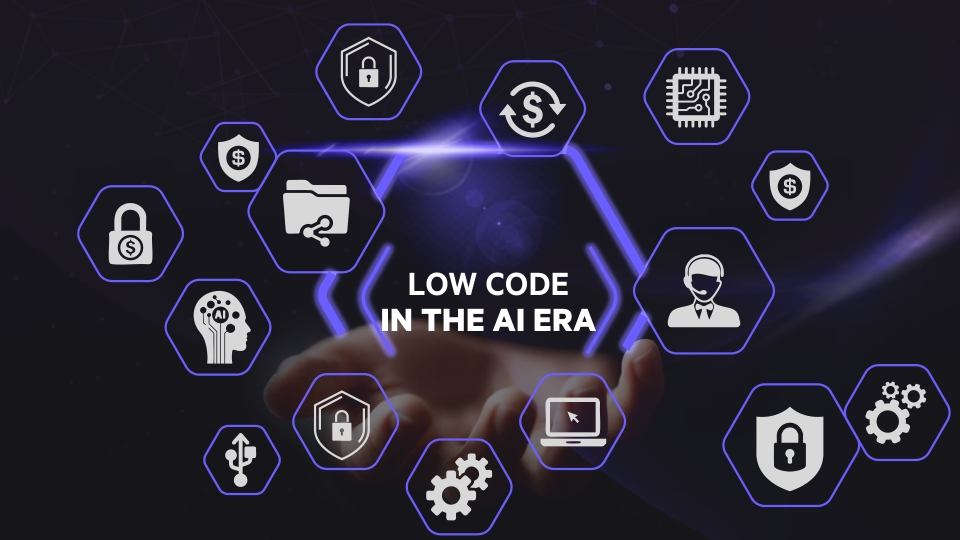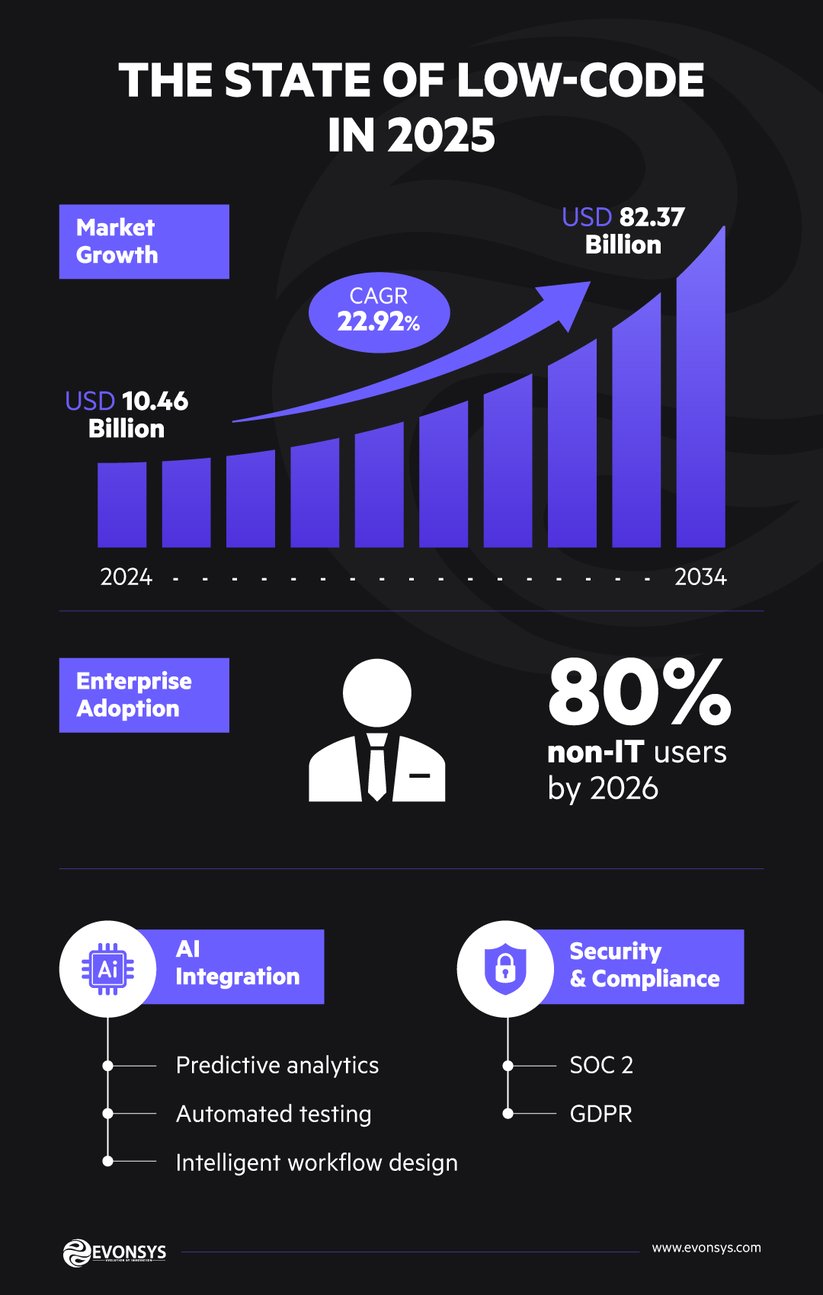
Low Code Business Solutions in 2025: Move Faster Without Losing Control
9 A.M, Monday. Your backlog board is full, your budget isn’t, and regulators don’t care that your best engineers are already spoken for. You can try to ship faster and tidy the risks later. Or you can slow everything down to stay safe. Both choices lose. The only durable path is to make speed and control move together.
Low code earns its keep when you treat it as an operating model for change, not a side project. Teams compress build time while keeping governance, audit, and security in the flow of work. Low-code and low code business solutions help you deliver quickly without losing evidence, ownership, or safety.
That is why adoption keeps climbing—Gartner expects low-code to account for more than 70% of application development activity by end of 2025.
Is Low Code Losing Steam in the Age of AI
Some leaders think so. If AI can generate code that build apps from a prompt, they argue, visual tooling adds little value. Early Low Code efforts in some firms did create side projects outside IT, which raised audit and security concerns. There is also a real fear of vendor lock-in, and questions about whether these platforms can meet the scale, performance, and integration needs of core systems. From that vantage point, the “safe” response seems obvious: return to hand-coded builds and centralize everything with engineering.
Why Low Code Is Here to Stay
Generating code is not the slow part. The hard work is connecting to live systems, protecting data, knowing who changed what and when, and evolving the process without surprises.
Modern Low Code addresses this directly: role-based access, separate environments, deployment approvals, audit trails, reusable connectors, and testable workflows. When a problem needs deep engineering, you extend the platform with code and keep moving. When it doesn’t, the platform gives you a faster, safer path that stays inside IT rather than drifting into shadow projects. Run it as an engineering practice with clear guardrails and you keep speed and control together—something a code-only approach still struggles to deliver consistently.
How Low Code Delivers Speed with Control
Governance built into the work
The slow part of delivery is not writing code. It is proving who can change what, when, and why. Low Code keeps that evidence inside the flow: roles, access reviews, separate environments, approvals, and audit trails that travel with every release. Builders do not “remember security”; the path itself enforces it.
Scale without the sprawl
Growth fails when every team invents the same parts. Low Code encourages reuse—components, connectors, naming, and standards—so new apps start on shoulders, not from scratch. That stops the spread of one-off spreadsheets and unowned forms, which is where risk and rework hide.
Integration that respects reality
Real systems are messy: legacy, SaaS, custom APIs, and data that lives in many places. Low Code connects to that reality with managed connectors and testable workflows. You get change you can roll back, logs you can show an auditor, and integrations that do not collapse when one endpoint moves.
Ready for What’s Next
As new channels or devices arrive, you add a connector, a rule, or a step—without rewriting the core flow. The platform’s reuse and versioning let you adopt what’s new while keeping today’s evidence and controls intact.
AI that stays inside the rails
AI can now draft, classify, and summarize. Low Code makes those steps safe to run in production. You control who can trigger a model, where outputs land, how exceptions route, and which actions require a second set of eyes. Velocity goes up, but ownership and audit stay visible.
A better talent equation
Most teams do not lack ideas. They lack capacity. Low Code widens the circle of capable builders under IT’s guardrails. Engineers spend time on the hard edges—architecture, performance, integration—while product owners and analysts ship well-governed slices. The result is faster delivery without trading away control.
Code Green and Sustainable
Consolidation is green. Reuse shared components, retire brittle spreadsheets and scripts, and let autoscaling match demand so idle compute shrinks. You cut duplicate effort, reduce error rates, and trim infrastructure waste—sustainability that shows up on the cost line.
Low Code ROI: Proof from the Field
- A global bank reduced loan approvals by 60% with low-code, while staying fully compliant.
- A telecom giant improved customer satisfaction by 25% after linking AI chatbots with low-code back-end workflows.
- The U.S. Army now uses low-code for building secure reports and operations systems — proving its value in high-security environments.

Low-code adoption hasn’t stalled or slowed down bit is maturing. Most teams use low code to move faster while keeping control—roles, reviews, environments, and audit in the path of work. Generative AI hasn’t replaced that need; it rides on top of it.
Adoption is broad. Multiple analysts still point to a 2025 tipping point: roughly 70% of new applications use low- or no-code. That signal shows up across mainstream tech press and advisory write-ups, not just vendor blogs. (InformationWeekEY)
The market is sizable and growing. Estimates vary by firm, but all show strong double-digit growth: Gartner commentary pegs ~$31.9B in 2024 for low-code development technologies, while independent market studies project ~22–23% CAGR through 2030. The precise number matters less than the direction: sustained investment and expansion. (bp-3.comApp Builder)
Who is building is changing. Large enterprises are shifting work closer to the business. Gartner’s view: by 2025, citizen developers in big companies outnumber professional developers ~4:1—a workforce change that explains why governance-by-default matters. (New Horizons)
AI is inside the platforms, not a replacement for them. 2025’s vendor landscape (Gartner’s MQ cycle) shows leaders embedding GenAI to assist design, testing, and data work—while the platform enforces access, segregation of environments, and audit trails. In short: AI speeds build; low code keeps it safe to ship. (Microsoft)
Business results hold up under scrutiny. Independent ROI work remains favorable at scale when teams run with guardrails: Forrester’s 2024 TEI on Microsoft’s Power Platform reports ~224% ROI with payback in months for a composite enterprise. (Methodology is published; caveats apply.) (Forrester)
In 2025, low code isn’t a fad nor a silver bullet. It’s the operating system for change: faster delivery paired with evidence, ownership, and reuse. That’s the center of gravity we’re writing toward in the rest of this piece.
The Future of Low Code
- Natural Language App Building
Leaders and employees will be able to describe a need in plain English, and AI + low-code will automatically build the app, with governance already built in.
- Deeper AI Collaboration
AI won’t just suggest workflows; it will help predict customer behavior, recommend processes, and optimize operations inside low-code apps.
- Industry-Specific Templates
Expect ready-made solutions for sectors like banking, healthcare, telecom, and government — reducing time-to-market even further.
- Global Compliance by Default
With rising regulations, low-code platforms will come preloaded with compliance frameworks for GDPR, HIPAA, RBI, and more, making apps secure “out of the box.”
- Seamless Emerging Tech Integration
From IoT-enabled devices to blockchain-based contracts, low-code will be the glue that connects emerging technologies into usable business solutions.
- A Shift in Workforce Roles
Employees will move from being “users” to “co-creators.” Developers will evolve into strategic enablers, focusing on design, governance, and innovation rather than repetitive coding.
- Hyper-Automation Ecosystems
Low-code will play a central role in hyper-automation — connecting AI, RPA, data analytics, and workflows into a single, intelligent system.
Why Leaders should Care about Low Code Business Solutions
Boards fund change that ships with evidence. Low Code lets you do that on repeat—faster delivery with clear ownership, audit, and reuse.
- Time to value. Ship in weeks, not quarters. Track cycle time, backlog burn, and time to first release.
- Risk posture. Access, approvals, and logs live in the flow of work. Evidence takes minutes, not days.
- Capacity. Widen the builder pool under IT guardrails. Keep engineers on architecture, data, and integrations.
- Cost to change. Reuse shared parts instead of rebuilding glue. Less duplication, cleaner upgrades.
- Portfolio control. One view of what is live, who owns it, and what changed. Shadow systems shrink.
- AI with safeguards. Models run inside roles, reviews, and retention rules. Speed without losing control.
Ask these questions in your next review:
- What did we ship in the last 60 days, and how do we know it is safe?
- Which components did we reuse, and who owns them?
- How fast can we produce evidence for an audit on any flow?
- Where does AI touch a decision, and who signs off on exceptions?
Final Word
In 2025, low code isn’t a fad or a silver bullet. It is the operating system for change—faster delivery with evidence, ownership, and reuse.
AI brings intelligence. Low code brings structure. People bring judgment and empathy. Together they build stronger, faster, more resilient systems.
In 2025 and beyond, low code remains the strategic backbone of digital transformation.